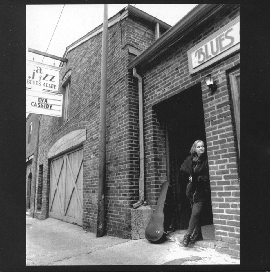
Several years had passed since the release of THE OTHER SIDE, and Chuck Brown had mostly returned to his Go-Go career. Chuck’s star power had booked Eva and the Eva Cassidy Band into the higher-profile local venues such as Blues Alley, the Barns of Wolf Trap, the Birchmere, and the Kennedy Center. Now Eva and the band were back performing midweek at smaller clubs.
The recording contract everybody expected for Eva had still not materialized. Representatives from record labels were coming to clubs and to the studio to hear Eva, but nothing was happening. (Read the interview with Al Dale, Eva’s manager, and the interview with guitarist Keith Grimes, to learn more about that.) Moving past frustration into action, Al, Chris, and Eva decided to self-produce a live album that could be used to promote Eva’s music, and maybe make her a little money too.
INTERVIEW: Laura Bligh spoke with Chris Biondo in November, 2015.
Laura: How did you arrange to record at Blues Alley? Did you rent the club?
Chris Biondo: Al Dale booked us into Blues Alley. He never had a problem getting us in there, he had relationships with people because he was with the Park Service. So he talked to whoever was in charge, to get the OK to do the recording. We didn’t pay rental, it was a regular night at the club. We made maybe $250 each, which we thought was pretty good!
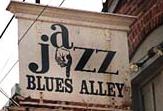
Laura: The notes for the NIGHTBIRD album say that Eva cashed in a pension from her job at Behnkes to pay for the recording.
Chris Biondo: I don’t remember that, I didn’t even know she had a pension. I know she did a cash advance on her credit card, and she told me your mother [Eva’s aunt, Isabel Cassidy Bligh] wrote her a check. The money from your mom, she used to pay for the manufacture of the CD and for the studio time. We had to rent a studio in Silver Spring because I didn’t have an ADAT machine.
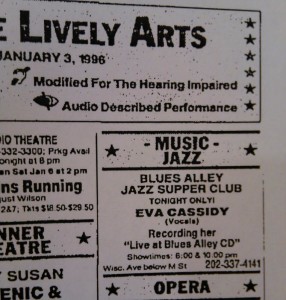
Roy did the mike set-ups. I remember the Blues Alley sound engineer wasn’t too thrilled with all the duplicate mikes! We used three ADAT machines that were all synched. Eva had two vocal mikes, and Keith had a vocal mike. We had two mikes that were pointed toward the audience to get the claps.
Do you really think people are interested in this?
Laura: Actually, they might be, and if they aren’t, they can skip ahead.
Chris Biondo: Raice had a total of 7 or 8 mikes, because each drum got a mike, and there were stereo mikes over the drums. There was a direct bass line from the back of the amp, so the bass wasn’t miked. Two mikes on the piano, a mike on Keith’s guitar amp, another on the electric guitar that Eva played on a lot of songs, and she had her acoustic guitar that had a pickup inside. That went directly to one of the tape decks and also to the house mixing board. Roy was set up at stage left, sitting on a chair at the front corner of the stage. He had a little mixer, but his main job during the show was to make sure the recording levels weren’t clipping, and when the tapes came near the end he had to be ready to pop in 3 new cassettes.
(End of interview.)
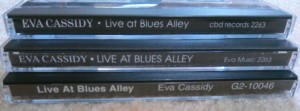
The two recording nights were scheduled for Tuesday, January 2, and Wednesday, January 3rd. Eva’s friends, family, and fans filled the club with enthusiastic well-wishers, as described in LIVE AT BLUES ALLEY — YOU ARE THERE. Eva had come down with a cold, but bravely performed two full sets both nights. On Tuesday she dressed up in a vintage 1940s outfit, even wearing high heels, which she discarded on stage after a few songs, to the delight of the audience. Eva’s friend Bryan McCulley had brought his camcorder and videotaped part of the second set.
The next evening brought the disastrous news that the previous night’s taping was unusable because of a persistent buzz on the tape. Roy and the sound people had eventually figured out that it was a conflict with the stage lights. The pressure was on. Eva was a “one-take wonder” in the recording studio, but this was going to be an expensive risk. Instead of having four sets to choose from, over two nights, it would all come down to the Wednesday night performances.
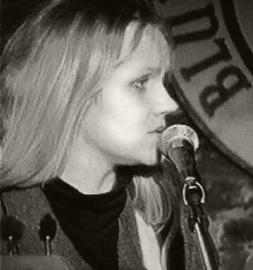
By performance time, Eva’s cold was worse, and she didn’t even bother changing clothes. She didn’t look her best, as Bryan’s videos show, and she didn’t sound her best. “My voice is a little raspy,” she told the audience, “but we’re gonna do the best we can with what we have.” Even on a bad night, Eva Cassidy was extraordinary. The audio and video recordings made that winter night would soon make history.
The first show was sold out, and the club was crowded. Eva’s cousin Martha Cassidy remembers the crowd as receptive. “I talked to Eva before the show and she was very nervous. She said her voice wasn’t doing what she wanted it to do. But she sounded great to me!” Jeff Muller agrees: “It was a beautiful night of music, even if Eva was battling a cold. I just remember being happy to be there.”
Eva’s parents Barbara and Hugh Cassidy were there, and Eva dedicated “What a Wonderful World” to them, adding, “Dad taught me how to play guitar.” When LIVE AT BLUES ALLEY was mastered, most of Eva’s spoken introductions were edited out, but Eva wanted this one to be included with the song on the album.
The ten o’clock set wasn’t sold out, which was typical of a mid-week show. The management announced to the earlier audience that anyone who wanted to stay was welcome to do so. Quite a few people did. Bryan McCulley again videotaped part of the second set. He had Eva’s permission, but Al Dale had told him only to tape snippets, not entire songs. This instruction, Bryan fortunately didn’t hear or ignored.
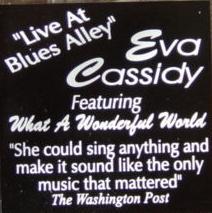
Here and there a note would be less than the perfection Eva demanded of herself. “After ‘Waly Waly,'” Martha Cassidy recalls, “Eva told the audience she was never going to do that song live again! And there was one place in ‘Over the Rainbow’ where her voice cracked. I was sitting far stage right near the soundboard, and had a good view of Chris Biondo. He smacked his forehead and made a face when that happened, but someone reminded him, that song wouldn’t be on the album” [because a studio version had already been released on THE OTHER SIDE album]. Chris doesn’t remember the incident, but admits, “I have a low flinch threshold. It was probably Lenny who was calming me down. We had slithered offstage and sat behind his piano during Eva’s solo numbers. Keith and Raice were trapped on the stage because of the drums.”
When Eva first heard the tapes from January 3rd, she was horrified and wanted to scrap the whole thing. Chris Biondo explains, “Eva didn’t realize that you can’t judge by the rough mix. You have to see how it sounds when it’s blended better. Eva was thinking, this is awful, her voice was too loud, it was dry. So to demonstrate, I put the whole mix through the board, put some reverb on. It made a huge difference. She understood it was not nearly as bad as she thought.” In fact, the final result, after mixing and mastering, made an album often praised by audiophile publications such as StereoTimes as a fitting test for high-end equipment.
True, Eva’s cold had diminished her vocal range and power. Her band members thought everybody had performed better on the first night of recording, which was ruined and had been taped over. As Keith Grimes commented in my interview with him, “I thought we had a much better record in us. But as it turned out, if we had discarded those sessions, we wouldn’t have had anything, which would have been too bad.”
Chris and Al persuaded Eva to go ahead and release the live album, saying “Everybody will know it’s a live album, it doesn’t have to be perfect,” (Al), and “There’s like forty songs on here. We’ll pick the best ones” (Chris). Finally she agreed, on condition that the studio recording of “Golden Thread” also be included.
Eva and Chris had several sessions with Larry Packer at Uncle Punchies studio, choosing the songs and mixing the album. Songs that had been on THE OTHER SIDE, like “You’ve Changed” and “Over the Rainbow,” weren’t even considered for the live album, and they had already done a recording of “Nightbird” that would be on the planned studio album. They eliminated the songs that Eva didn’t want to have released, and concentrated on the ones that sounded best to her. Chris Biondo confesses, “She didn’t really want ‘Take Me to the River’ to be on there. I picked that one, I told her I got to pick one!”
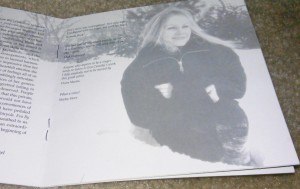
While some of the snow was still on the ground, Eva arranged for Blues Alley to put her name back on the marquee for a photo shoot. Her friend Larry Melton shot a couple of rolls of film of Eva in the alley outside the club with her guitar. One was used for the cover of LIVE AT BLUES ALLEY, and another is now the cover photo for NIGHTBIRD. (He’s a really good photographer. Check out his website. Larry also played upright bass on a number of tracks on Eva’s albums.)
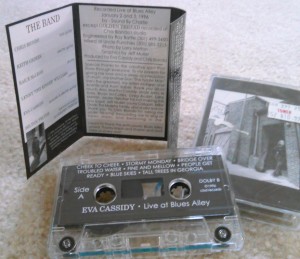
Next, Eva got to work planning the album design and credits, working with another of her multi-talented friends, graphic designer and musician Jeff Muller, her neighbor in Annapolis. Jeff told me, “Eva just called me one day and asked if I would do it for her, which I was more than happy to do. We didn’t discuss it much — either she or Larry sent me the photos and I put it together the way I thought it should be, and she seemed happy with it. More than anything, I wanted it to be elegant and to showcase Larry’s great photography. Since he was shooting in B&W I decided that the design should mimic it.”
In late May, Chris and Eva drove out into the Virginia countryside to pick up the finished CDs and cassettes. Chris can’t remember where they went, other than “It took us a while to get there. We got lost. There were cows.” As he told Dave McKenna of The Washington Post, ‘“We’d ordered a lot of a thousand CDs,” says Biondo. “I remember driving with her to Virginia to go pick them up from the CD plant. She thought we bought too many. So the whole ride she was saying she knows she’ll have boxes and boxes of them lying around forever, really concerned that for the rest of her life she’d be seeing these things in her basement. I was telling her don’t worry about that, that it would be fine. But, I thought it would be a great thing to sell the 1,000 we had.”’
They loaded the boxes into the van, and “We drove away, but only went about 30 feet. We both grabbed a CD and started ripping off the cellophane. That was the first time I even saw the cover picture and the thank-yous. We listened to it on the drive back. About a week later, we were playing the radio in the car, and WPFW played ‘Stormy Monday.'”
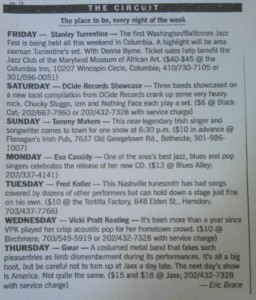
LIVE AT BLUES ALLEY was released to the public on May 20, 1996, at Blues Alley. The event was a big success. Celia Murphy tells me, “After the gig, people crowded around her to purchase her CDs, and she was a bit overwhelmed. We had to get the people a bit more organized, and put Eva at a little table.”
Want to know more about what it was like to be at Blues Alley on January 3, 1996? Read the companion article to this one, LIVE AT BLUES ALLEY: YOU ARE THERE.